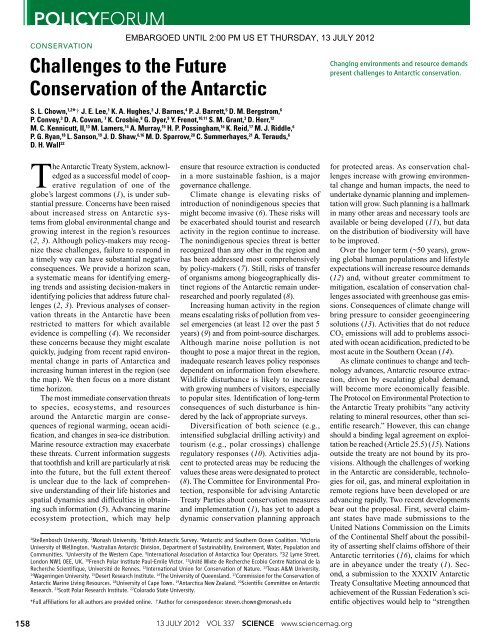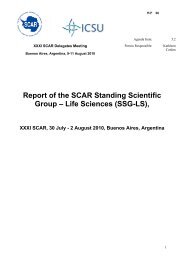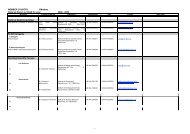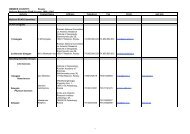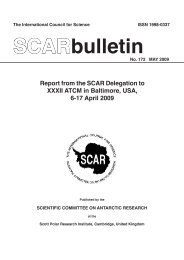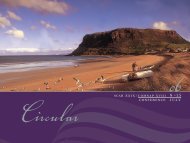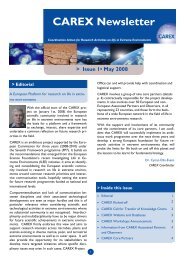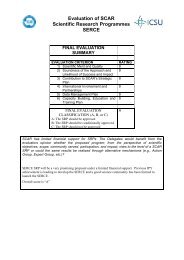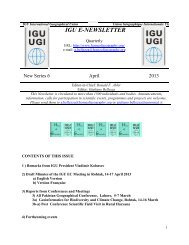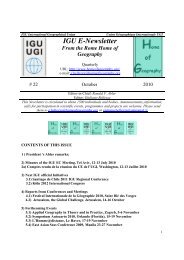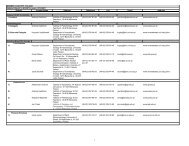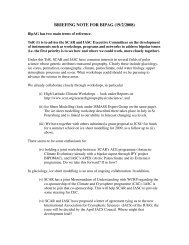Chown, S.L., et al, 2012, Challenges to the Future Conservation of ...
Chown, S.L., et al, 2012, Challenges to the Future Conservation of ...
Chown, S.L., et al, 2012, Challenges to the Future Conservation of ...
You also want an ePaper? Increase the reach of your titles
YUMPU automatically turns print PDFs into web optimized ePapers that Google loves.
POLICYFORUM<br />
CONSERVATION<br />
EMBARGOED UNTIL 2:00 PM US ET THURSDAY, 13 JULY <strong>2012</strong><br />
Ch<strong>al</strong>lenges <strong>to</strong> <strong>the</strong> <strong>Future</strong><br />
<strong>Conservation</strong> <strong>of</strong> <strong>the</strong> Antarctic<br />
S. L. <strong>Chown</strong>, 1,2 * J. E. Lee, 1 K. A. Hughes, 3 J. Barnes, 4 P. J. Barr<strong>et</strong>t, 5 D. M. Bergstrom, 6<br />
P. Convey, 3 D. A. Cowan, 7 K. Crosbie, 8 G. Dyer, 9 Y. Frenot, 10,11 S. M. Grant, 3 D. Herr, 12<br />
M. C. Kennicutt, II, 13 M. Lamers, 14 A. Murray, 15 H. P. Possingham, 16 K. Reid, 17 M. J. Riddle, 6<br />
P. G. Ryan, 18 L. Sanson, 19 J. D. Shaw, 6,16 M. D. Sparrow, 20 C. Summerhayes, 21 A. Terauds, 6<br />
D. H. W<strong>al</strong>l 22<br />
Changing environments and resource demands<br />
present ch<strong>al</strong>lenges <strong>to</strong> Antarctic conservation.<br />
The Antarctic Treaty System, acknowledged<br />
as a successful model <strong>of</strong> cooperative<br />
regulation <strong>of</strong> one <strong>of</strong> <strong>the</strong><br />
globe’s largest commons (1), is under substanti<strong>al</strong><br />
pressure. Concerns have been raised<br />
about increased stress on Antarctic systems<br />
from glob<strong>al</strong> environment<strong>al</strong> change and<br />
growing interest in <strong>the</strong> region’s resources<br />
(2, 3). Although policy-makers may recognize<br />
<strong>the</strong>se ch<strong>al</strong>lenges, failure <strong>to</strong> respond in<br />
a timely way can have substanti<strong>al</strong> negative<br />
consequences. We provide a horizon scan,<br />
a systematic means for identifying emerging<br />
trends and assisting decision-makers in<br />
identifying policies that address future ch<strong>al</strong>lenges<br />
(2, 3). Previous an<strong>al</strong>yses <strong>of</strong> conservation<br />
threats in <strong>the</strong> Antarctic have been<br />
restricted <strong>to</strong> matters for which available<br />
evidence is compelling (4). We reconsider<br />
<strong>the</strong>se concerns because <strong>the</strong>y might esc<strong>al</strong>ate<br />
quickly, judging from recent rapid environment<strong>al</strong><br />
change in parts <strong>of</strong> Antarctica and<br />
increasing human interest in <strong>the</strong> region (see<br />
<strong>the</strong> map). We <strong>the</strong>n focus on a more distant<br />
time horizon.<br />
The most immediate conservation threats<br />
<strong>to</strong> species, ecosystems, and resources<br />
around <strong>the</strong> Antarctic margin are consequences<br />
<strong>of</strong> region<strong>al</strong> warming, ocean acidification,<br />
and changes in sea-ice distribution.<br />
Marine resource extraction may exacerbate<br />
<strong>the</strong>se threats. Current information suggests<br />
that <strong>to</strong>othfish and krill are particularly at risk<br />
in<strong>to</strong> <strong>the</strong> future, but <strong>the</strong> full extent <strong>the</strong>re<strong>of</strong><br />
is unclear due <strong>to</strong> <strong>the</strong> lack <strong>of</strong> comprehensive<br />
understanding <strong>of</strong> <strong>the</strong>ir life his<strong>to</strong>ries and<br />
spati<strong>al</strong> dynamics and difficulties in obtaining<br />
such information (5). Advancing marine<br />
ecosystem protection, which may help<br />
ensure that resource extraction is conducted<br />
in a more sustainable fashion, is a major<br />
governance ch<strong>al</strong>lenge.<br />
Climate change is elevating risks <strong>of</strong><br />
introduction <strong>of</strong> nonindigenous species that<br />
might become invasive (6). These risks will<br />
be exacerbated should <strong>to</strong>urist and research<br />
activity in <strong>the</strong> region continue <strong>to</strong> increase.<br />
The nonindigenous species threat is b<strong>et</strong>ter<br />
recognized than any o<strong>the</strong>r in <strong>the</strong> region and<br />
has been addressed most comprehensively<br />
by policy-makers (7). Still, risks <strong>of</strong> transfer<br />
<strong>of</strong> organisms among biogeographic<strong>al</strong>ly distinct<br />
regions <strong>of</strong> <strong>the</strong> Antarctic remain underresearched<br />
and poorly regulated (8).<br />
Increasing human activity in <strong>the</strong> region<br />
means esc<strong>al</strong>ating risks <strong>of</strong> pollution from vessel<br />
emergencies (at least 12 over <strong>the</strong> past 5<br />
years) (9) and from point-source discharges.<br />
Although marine noise pollution is not<br />
thought <strong>to</strong> pose a major threat in <strong>the</strong> region,<br />
inadequate research leaves policy responses<br />
dependent on information from elsewhere.<br />
Wildlife disturbance is likely <strong>to</strong> increase<br />
with growing numbers <strong>of</strong> visi<strong>to</strong>rs, especi<strong>al</strong>ly<br />
<strong>to</strong> popular sites. Identification <strong>of</strong> long-term<br />
consequences <strong>of</strong> such disturbance is hindered<br />
by <strong>the</strong> lack <strong>of</strong> appropriate surveys.<br />
Diversification <strong>of</strong> both science (e.g.,<br />
intensified subglaci<strong>al</strong> drilling activity) and<br />
<strong>to</strong>urism (e.g., polar crossings) ch<strong>al</strong>lenge<br />
regula<strong>to</strong>ry responses (10). Activities adjacent<br />
<strong>to</strong> protected areas may be reducing <strong>the</strong><br />
v<strong>al</strong>ues <strong>the</strong>se areas were designated <strong>to</strong> protect<br />
(8). The Committee for Environment<strong>al</strong> Protection,<br />
responsible for advising Antarctic<br />
Treaty Parties about conservation measures<br />
and implementation (1), has y<strong>et</strong> <strong>to</strong> adopt a<br />
dynamic conservation planning approach<br />
1<br />
Stellenbosch University. 2 Monash University. 3 British Antarctic Survey. 4 Antarctic and Sou<strong>the</strong>rn Ocean Co<strong>al</strong>ition. 5 Vic<strong>to</strong>ria<br />
University <strong>of</strong> Welling<strong>to</strong>n. 6 Austr<strong>al</strong>ian Antarctic Division, Department <strong>of</strong> Sustainability, Environment, Water, Population and<br />
Communities. 7 University <strong>of</strong> <strong>the</strong> Western Cape. 8 Internation<strong>al</strong> Association <strong>of</strong> Antarctica Tour Opera<strong>to</strong>rs. 9 32 Lyme Stre<strong>et</strong>,<br />
London NW1 0EE, UK. 10 French Polar Institute Paul-Emile Vic<strong>to</strong>r. 11 Unité Mixte de Recherche Ecobio Centre Nation<strong>al</strong> de la<br />
Recherche Scientifique, Université de Rennes. 12 Internation<strong>al</strong> Union for <strong>Conservation</strong> <strong>of</strong> Nature. 13 Texas A&M University.<br />
14<br />
Wageningen University. 15 Desert Research Institute. 16 The University <strong>of</strong> Queensland. 17 Commission for <strong>the</strong> <strong>Conservation</strong> <strong>of</strong><br />
Antarctic Marine Living Resources. 18 University <strong>of</strong> Cape Town. 19 Antarctica New Ze<strong>al</strong>and. 20 Scientific Committee on Antarctic<br />
Research. 21 Scott Polar Research Institute. 22 Colorado State University.<br />
*Full affiliations for <strong>al</strong>l authors are provided online. Author for correspondence: steven.chown@monash.edu<br />
for protected areas. As conservation ch<strong>al</strong>lenges<br />
increase with growing environment<strong>al</strong><br />
change and human impacts, <strong>the</strong> need <strong>to</strong><br />
undertake dynamic planning and implementation<br />
will grow. Such planning is a h<strong>al</strong>lmark<br />
in many o<strong>the</strong>r areas and necessary <strong>to</strong>ols are<br />
available or being developed (11), but data<br />
on <strong>the</strong> distribution <strong>of</strong> biodiversity will have<br />
<strong>to</strong> be improved.<br />
Over <strong>the</strong> longer term (~50 years), growing<br />
glob<strong>al</strong> human populations and lifestyle<br />
expectations will increase resource demands<br />
(12) and, without greater commitment <strong>to</strong><br />
mitigation, esc<strong>al</strong>ation <strong>of</strong> conservation ch<strong>al</strong>lenges<br />
associated with greenhouse gas emissions.<br />
Consequences <strong>of</strong> climate change will<br />
bring pressure <strong>to</strong> consider geoengineering<br />
solutions (13). Activities that do not reduce<br />
CO 2 emissions will add <strong>to</strong> problems associated<br />
with ocean acidification, predicted <strong>to</strong> be<br />
most acute in <strong>the</strong> Sou<strong>the</strong>rn Ocean (14).<br />
As climate continues <strong>to</strong> change and technology<br />
advances, Antarctic resource extraction,<br />
driven by esc<strong>al</strong>ating glob<strong>al</strong> demand,<br />
will become more economic<strong>al</strong>ly feasible.<br />
The Pro<strong>to</strong>col on Environment<strong>al</strong> Protection <strong>to</strong><br />
<strong>the</strong> Antarctic Treaty prohibits “any activity<br />
relating <strong>to</strong> miner<strong>al</strong> resources, o<strong>the</strong>r than scientific<br />
research.” However, this can change<br />
should a binding leg<strong>al</strong> agreement on exploitation<br />
be reached (Article 25.5) (15). Nations<br />
outside <strong>the</strong> treaty are not bound by its provisions.<br />
Although <strong>the</strong> ch<strong>al</strong>lenges <strong>of</strong> working<br />
in <strong>the</strong> Antarctic are considerable, technologies<br />
for oil, gas, and miner<strong>al</strong> exploitation in<br />
remote regions have been developed or are<br />
advancing rapidly. Two recent developments<br />
bear out <strong>the</strong> propos<strong>al</strong>. First, sever<strong>al</strong> claimant<br />
states have made submissions <strong>to</strong> <strong>the</strong><br />
United Nations Commission on <strong>the</strong> Limits<br />
<strong>of</strong> <strong>the</strong> Continent<strong>al</strong> Shelf about <strong>the</strong> possibility<br />
<strong>of</strong> asserting shelf claims <strong>of</strong>fshore <strong>of</strong> <strong>the</strong>ir<br />
Antarctic terri<strong>to</strong>ries (16), claims for which<br />
are in abeyance under <strong>the</strong> treaty (1). Second,<br />
a submission <strong>to</strong> <strong>the</strong> XXXIV Antarctic<br />
Treaty Consultative Me<strong>et</strong>ing announced that<br />
achievement <strong>of</strong> <strong>the</strong> Russian Federation’s scientific<br />
objectives would help <strong>to</strong> “streng<strong>the</strong>n<br />
158<br />
13 JULY <strong>2012</strong> VOL 337 SCIENCE www.sciencemag.org
POLICYFORUM<br />
EMBARGOED UNTIL 2:00 PM US ET THURSDAY, 13 JULY <strong>2012</strong><br />
<strong>the</strong>ir nature, extent, and trajec<strong>to</strong>ries and by<br />
making <strong>the</strong> outcomes more rapidly and readily<br />
accessible <strong>to</strong> <strong>the</strong> policy environment.<br />
Action <strong>to</strong> adapt <strong>to</strong> and mitigate <strong>the</strong> consequences<br />
<strong>of</strong> change must be taken by <strong>al</strong>l Antarctic<br />
visi<strong>to</strong>rs, opera<strong>to</strong>rs, and nation<strong>al</strong> programs.<br />
The most potenti<strong>al</strong> for effective action<br />
lies with <strong>the</strong> Antarctic Treaty System itself.<br />
This will require improved ways <strong>to</strong> use scientific<br />
information effectively and an increase<br />
in <strong>the</strong> speed <strong>of</strong> decision-making. The greatest<br />
ch<strong>al</strong>lenge will be addressing threats that<br />
are glob<strong>al</strong> in sc<strong>al</strong>e, but with impacts that are<br />
being re<strong>al</strong>ized most significantly in <strong>the</strong> Antarctic.<br />
To do so requires greater engagement<br />
with o<strong>the</strong>r internation<strong>al</strong> environment<strong>al</strong> policy<br />
instruments and organizations.<br />
1300<br />
0<br />
Predicted increase in<br />
number <strong>of</strong> degree days<br />
by 2100 under IPCC<br />
Scenario A1B<br />
Number <strong>of</strong> visi<strong>to</strong>rs landing<br />
1 – 99<br />
100 – 999<br />
1000 – 9999<br />
10000 +<br />
Predicted increase in degree days for vascular plants b<strong>et</strong>ween 2007–2008 and 2100, overlaid with science<br />
and <strong>to</strong>urist visi<strong>to</strong>r activity in 2007–2008. Data from (6, 8).<br />
<strong>the</strong> economic capacity <strong>of</strong> Russia through <strong>the</strong><br />
use <strong>of</strong> marine biologic<strong>al</strong> resources available<br />
in <strong>the</strong> Sou<strong>the</strong>rn Ocean, and complex investigations<br />
<strong>of</strong> <strong>the</strong> Antarctic miner<strong>al</strong>, hydrocarbon<br />
and o<strong>the</strong>r natur<strong>al</strong> resources” (17). Data<br />
<strong>to</strong> ev<strong>al</strong>uate hydrocarbon and miner<strong>al</strong> deposits<br />
could be ga<strong>the</strong>red, with attendant environment<strong>al</strong><br />
risks, as part <strong>of</strong> legitimate scientific<br />
programs. Managing activities that bridge<br />
research and exploitation is a ch<strong>al</strong>lenge for<br />
o<strong>the</strong>r internation<strong>al</strong> agreements.<br />
Marine resource harvesting for human<br />
consumption is a current threat. Bioprospecting<br />
in <strong>the</strong> region could represent<br />
a fur<strong>the</strong>r ch<strong>al</strong>lenge if it leads <strong>to</strong> substantive<br />
nondisclosure <strong>of</strong> information. Information<br />
sharing has been a ch<strong>al</strong>lenge within <strong>the</strong><br />
treaty (1), and pr<strong>of</strong>it-motivated restrictions<br />
would fur<strong>the</strong>r hamper dynamic spati<strong>al</strong> conservation<br />
planning and management (8, 11).<br />
Discussions about permanent s<strong>et</strong>tlements<br />
<strong>of</strong> parts <strong>of</strong> Antarctica have typic<strong>al</strong>ly<br />
revolved around <strong>the</strong> activities <strong>of</strong> some<br />
claimant states. However, as <strong>to</strong>urism diversifies<br />
and includes more land-based components,<br />
and as science and <strong>to</strong>urism ventures<br />
share resources (18), <strong>the</strong> probability <strong>of</strong> more<br />
permanent residents will increase, as is <strong>the</strong><br />
case for those who serve <strong>the</strong>se industries<br />
on <strong>the</strong> Arctic island <strong>of</strong> Sv<strong>al</strong>bard. Permanent<br />
human s<strong>et</strong>tlements can be acceptable within<br />
<strong>the</strong> charge <strong>to</strong> use <strong>the</strong> continent for “peaceful<br />
purposes” but are likely <strong>to</strong> bring a broad<br />
range <strong>of</strong> conservation ch<strong>al</strong>lenges. Although<br />
<strong>the</strong> treaty has provisions <strong>to</strong> de<strong>al</strong> with conservation<br />
threats, it does not currently regulate<br />
resident citizens.<br />
The five decades since entry in<strong>to</strong> force <strong>of</strong><br />
<strong>the</strong> Antarctic Treaty have seen a quickening in<br />
<strong>the</strong> pace <strong>of</strong> glob<strong>al</strong> change, reflected in accelerating<br />
rates <strong>of</strong> ice loss in <strong>the</strong> Antarctic (19).<br />
Growing use <strong>of</strong> <strong>the</strong> continent <strong>to</strong>g<strong>et</strong>her with<br />
such change will mean substanti<strong>al</strong> impacts on<br />
ecosystems, including those that are glob<strong>al</strong>ly<br />
unmatched, such as in <strong>the</strong> McMurdo Dry V<strong>al</strong>leys.<br />
The capability <strong>of</strong> current conservation<br />
governance arrangements <strong>to</strong> de<strong>al</strong> with <strong>the</strong>se<br />
ch<strong>al</strong>lenges may be outpaced.<br />
The scientific community can help<br />
address <strong>the</strong>se ch<strong>al</strong>lenges by investigating<br />
References and Notes<br />
1. P. A. Berkman, M. A. Lang, D. W. H. W<strong>al</strong><strong>to</strong>n, Eds., Science<br />
Diplomacy: Antarctica, Science, and <strong>the</strong> Governance <strong>of</strong><br />
Internation<strong>al</strong> Spaces (Smithsonian Institution Scholarly<br />
Press, Washing<strong>to</strong>n, DC, 2011).<br />
2. W. J. Su<strong>the</strong>rland <strong>et</strong> <strong>al</strong>., Trends Ecol. Evol. 27, 12 (<strong>2012</strong>).<br />
3. For a description <strong>of</strong> <strong>the</strong> approach and participants and<br />
addition<strong>al</strong> information, see supplementary materi<strong>al</strong>s.<br />
4. T. Tin <strong>et</strong> <strong>al</strong>., Antarct. Sci. 21, 3 (2009).<br />
5. L. K. Blight <strong>et</strong> <strong>al</strong>., Science 330, 1316 (2010).<br />
6. S. L. <strong>Chown</strong> <strong>et</strong> <strong>al</strong>., Proc. Natl. Acad. Sci. U.S.A. 109,<br />
4938 (<strong>2012</strong>).<br />
7. Committee for Environment<strong>al</strong> Protection, Non-native<br />
Species Manu<strong>al</strong> (2011); www.ats.aq/documents/atcm34/<br />
ww/atcm34_ww004_e.pdf.<br />
8. A. Terauds <strong>et</strong> <strong>al</strong>., Divers. Distrib. 18, 726 (<strong>2012</strong>).<br />
9. V. Ruoppolo, E. J. Woehler, K. Morgan, C. J. Clumper,<br />
Polar Rec. (Gr. Brit.) (<strong>2012</strong>) (Great Britain). 10.1017/<br />
S0032247411000763<br />
10. Antarctic Treaty Consultative Me<strong>et</strong>ing XXXIV Information<br />
Paper 18, www.ats.aq/documents/ATCM34/ip/ATCM34_<br />
ip018_e.doc.<br />
11. D. B. Segan, E. T. Game, M. E. Watts, R. R. Stewart, H. P.<br />
Possingham, Environ. Model. S<strong>of</strong>tw. 26, 1434 (2011).<br />
12. G. Dyer, Climate Wars: The Fight for Surviv<strong>al</strong> as <strong>the</strong> World<br />
Overheats (Oneworld Publications, Oxford, 2010).<br />
13. N. E. Vaughan, T. M. Len<strong>to</strong>n, Clim. Change 109, 745<br />
(2011).<br />
14. B. I. McNeil, R. J. Matear, Proc. Natl. Acad. Sci. U.S.A.<br />
105, 18860 (2008).<br />
15. Pro<strong>to</strong>col on Environment<strong>al</strong> Protection <strong>to</strong> <strong>the</strong> Antarctic<br />
Treaty, www.ats.aq/documents/recatt/Att006_e.pdf.<br />
16. C. C. Joyner, in (1), pp. 97–102.<br />
17. Antarctic Treaty Consultative Me<strong>et</strong>ing XXXIV Working<br />
Paper 55, www.ats.aq/documents/ATCM34/wp/ATCM34_<br />
wp055_e.doc.<br />
18. Antarctic Treaty Consultative Me<strong>et</strong>ing XXXII Information<br />
Paper 23, www.ats.aq/documents/ATCM32/ip/ATCM32_<br />
ip023_rev1_e.doc.<br />
19. E. Rignot, I. Velicogna, M. R. van den Broeke, A.<br />
Monaghan, J. Lenaerts, Geophys. Res. L<strong>et</strong>t. 38, L05503<br />
(2011).<br />
Acknowledgments: Views expressed here reflect authors’<br />
person<strong>al</strong> perspectives, not necessarily <strong>the</strong> policy positions<br />
<strong>of</strong> <strong>the</strong>ir home organizations. This work was supported by <strong>the</strong><br />
Scientific Committee on Antarctic Research, Antarctica New<br />
Ze<strong>al</strong>and, <strong>the</strong> South African Nation<strong>al</strong> Research Foundation, and<br />
a Martha T. Muse award (S.L.C.). A. Macey, N. Gilbert, and M.<br />
McGeoch provided useful comments.<br />
Supplementary Materi<strong>al</strong>s<br />
www.sciencemag.org/cgi/content/full/337/6091/PAGE/DC1<br />
10.1126/science.1222821<br />
www.sciencemag.org SCIENCE VOL 337 13 JULY <strong>2012</strong> 159


